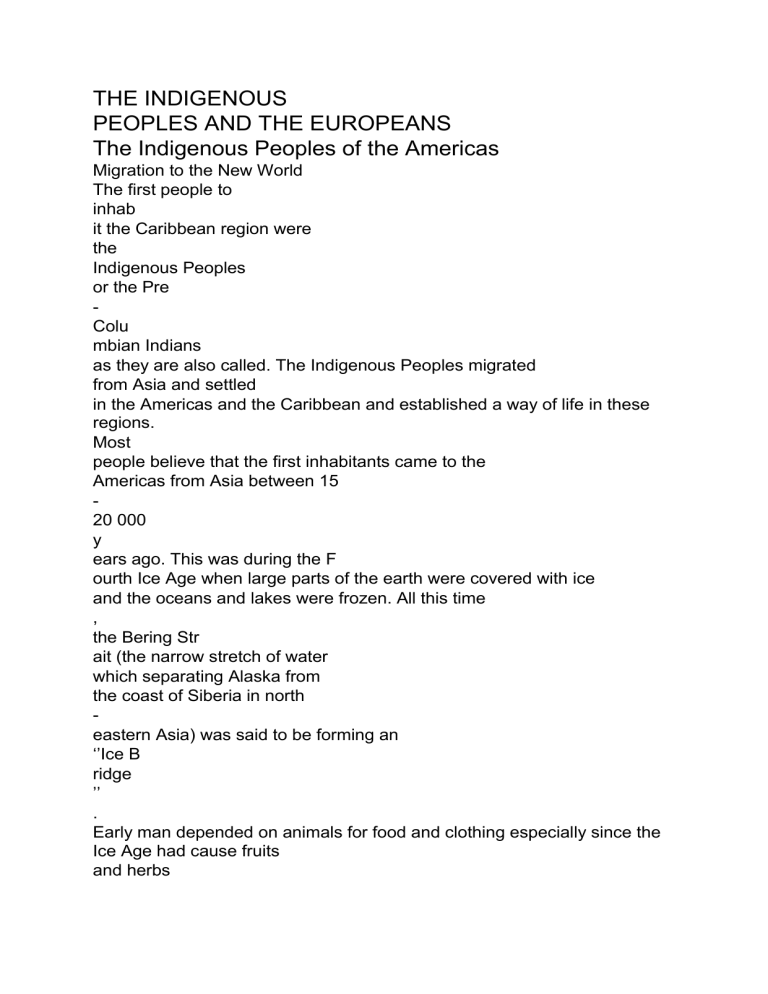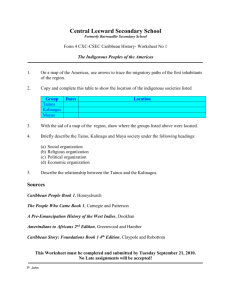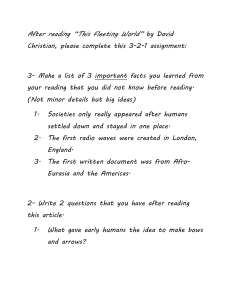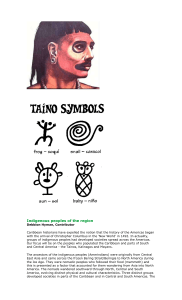
THE INDIGENOUS PEOPLES AND THE EUROPEANS The Indigenous Peoples of the Americas Migration to the New World The first people to inhab it the Caribbean region were the Indigenous Peoples or the Pre Colu mbian Indians as they are also called. The Indigenous Peoples migrated from Asia and settled in the Americas and the Caribbean and established a way of life in these regions. Most people believe that the first inhabitants came to the Americas from Asia between 15 20 000 y ears ago. This was during the F ourth Ice Age when large parts of the earth were covered with ice and the oceans and lakes were frozen. All this time , the Bering Str ait (the narrow stretch of water which separating Alaska from the coast of Siberia in north eastern Asia) was said to be forming an ‘’Ice B ridge ’’ . Early man depended on animals for food and clothing especially since the Ice Age had cause fruits and herbs to become scarce. These hunters were nomadic so they travelled from place to place in search of food and shelter. These hunters were following her ds of animals like mammoths, dear and caribou without knowing that they were crossing from one continent to an other. These Asian migrants are usually referred to as Mongoloids si nce they came from Mongolia in C entral Asia. Settlement Patterns in the Americas The Asian migrants settled in North America and continued to hunt. As time passed, these people developed a way of life and also many languages . They lived in small family units and made their homes from the skins of the animals they hunted. Their homes are called tents. During the next thousands of years, they wa ndered in many directions. Those who occupied t he same area, spoke the same language , and shared a common language are said to belong to a tribe. Some Amerindians lived in Eastern Canada (Mohawk) while some occupied the bleak and barren Artic regions. They were known as Eskimos. In North America, the A merindians settled in areas such as the Florida Peninsula and Alaska. Some also settled in the Prairies of the Great Plains. The Incas settled in countries such as Chile, Argentina, Nicaragua , and Peru. The Aztecs settled in Mexico while the Maya settled in the Yucatan Peninsula, Guatemala, Honduras, parts of Belize, El Salvador, and Southern Mexico. The Mayas, Incas and Aztecs each developed civilizations which flourished and they are known as Mesoamericans. Settlement Patterns in t he Caribbean The first group of Amerindians to arrive in the Caribbean were the Ciboney who settl ed mainly in Cuba. They migrated northwards from Suriname, Eastern Venezuela and Guyana in South America. Archaeologists have not found much evidence in order to describe what they were like or how they lived. This is because they left few artefacts behind. Sometime afterwards , the Ciboney were followed by the Tainos (Arawaks) and Kalinagos (Caribs). The Tainos ’ original homeland was in the forest between the Or inoco and Amazon Rivers in South America. They travelled in large canoes and usually settled on each island they encountered. Then after a few years, some would move onto another island. The Arawaks were divided into two principle tribes which are the Luca yos in the Bahamas and the Tainos in the Greater Antilles. The Kalinagos followed the Tainos into the Caribbean. They lived further south in the jungles around the Orinoco. They also THE INDIGENOUS PEOPLES AND THE EUROPEANS The Indigenous Peoples of the Americas Migration to the New World The first people to inhab it the Caribbean region were the Indigenous Peoples or the Pre Colu mbian Indians as they are also called. The Indigenous Peoples migrated from Asia and settled in the Americas and the Caribbean and established a way of life in these regions. Most people believe that the first inhabitants came to the Americas from Asia between 15 20 000 y ears ago. This was during the F ourth Ice Age when large parts of the earth were covered with ice and the oceans and lakes were frozen. All this time , the Bering Str ait (the narrow stretch of water which separating Alaska from the coast of Siberia in north eastern Asia) was said to be forming an ‘’Ice B ridge ’’ . Early man depended on animals for food and clothing especially since the Ice Age had cause fruits and herbs to become scarce. These hunters were nomadic so they travelled from place to place in search of food and shelter. These hunters were following her ds of animals like mammoths, dear and caribou without knowing that they were crossing from one continent to an other. These Asian migrants are usually referred to as Mongoloids si nce they came from Mongolia in C entral Asia. Settlement Patterns in the Americas The Asian migrants settled in North America and continued to hunt. As time passed, these people developed a way of life and also many languages . They lived in small family units and made their homes from the skins of the animals they hunted. Their homes are called tents. During the next thousands of years, they wa ndered in many directions. Those who occupied t he same area, spoke the same language , and shared a common language are said to belong to a tribe. Some Amerindians lived in Eastern Canada (Mohawk) while some occupied the bleak and barren Artic regions. They were known as Eskimos. In North America, the A merindians settled in areas such as the Florida Peninsula and Alaska. Some also settled in the Prairies of the Great Plains. The Incas settled in countries such as Chile, Argentina, Nicaragua , and Peru. The Aztecs settled in Mexico while the Maya settled in the Yucatan Peninsula, Guatemala, Honduras, parts of Belize, El Salvador, and Southern Mexico. The Mayas, Incas and Aztecs each developed civilizations which flourished and they are known as Mesoamericans. Settlement Patterns in t he Caribbean The first group of Amerindians to arrive in the Caribbean were the Ciboney who settl ed mainly in Cuba. They migrated northwards from Suriname, Eastern Venezuela and Guyana in South America. Archaeologists have not found much evidence in order to describe what they were like or how they lived. This is because they left few artefacts behind. Sometime afterwards , the Ciboney were followed by the Tainos (Arawaks) and Kalinagos (Caribs). The Tainos ’ original homeland was in the forest between the Or inoco and Amazon Rivers in South America. They travelled in large canoes and usually settled on each island they encountered. Then after a few years, some would move onto another island. The Arawaks were divided into two principle tribes which are the Luca yos in the Bahamas and the Tainos in the Greater Antilles. The Kalinagos followed the Tainos into the Caribbean. They lived further south in the jungles around the Orinoco. They also



